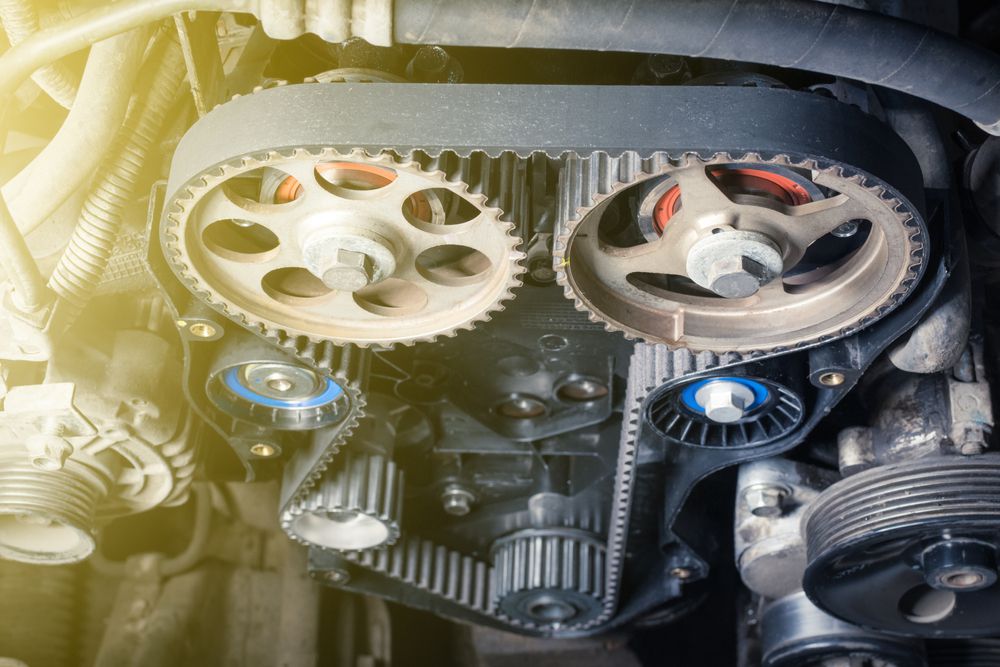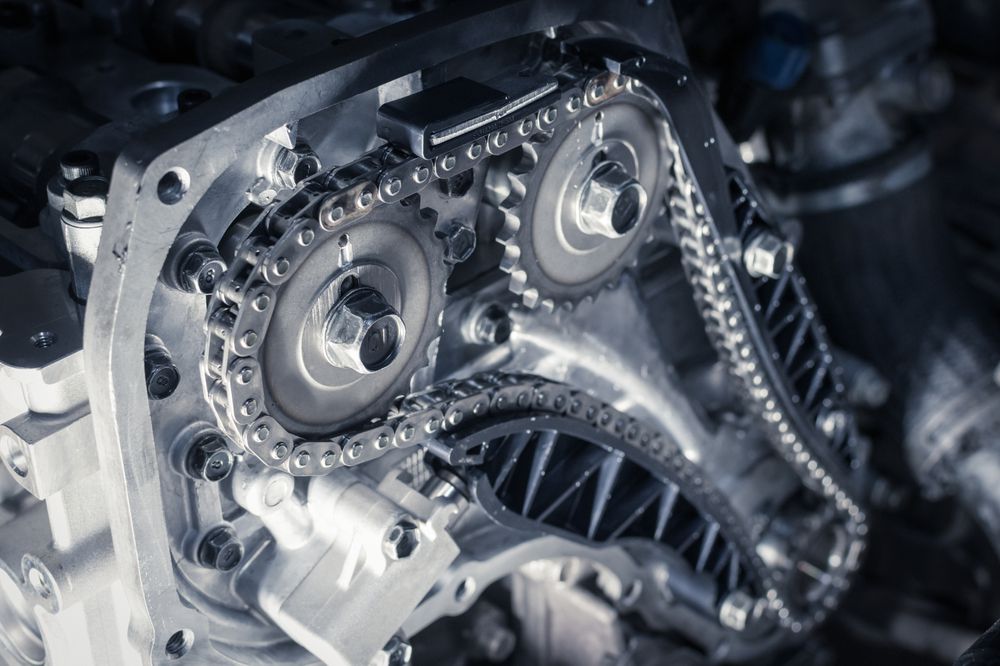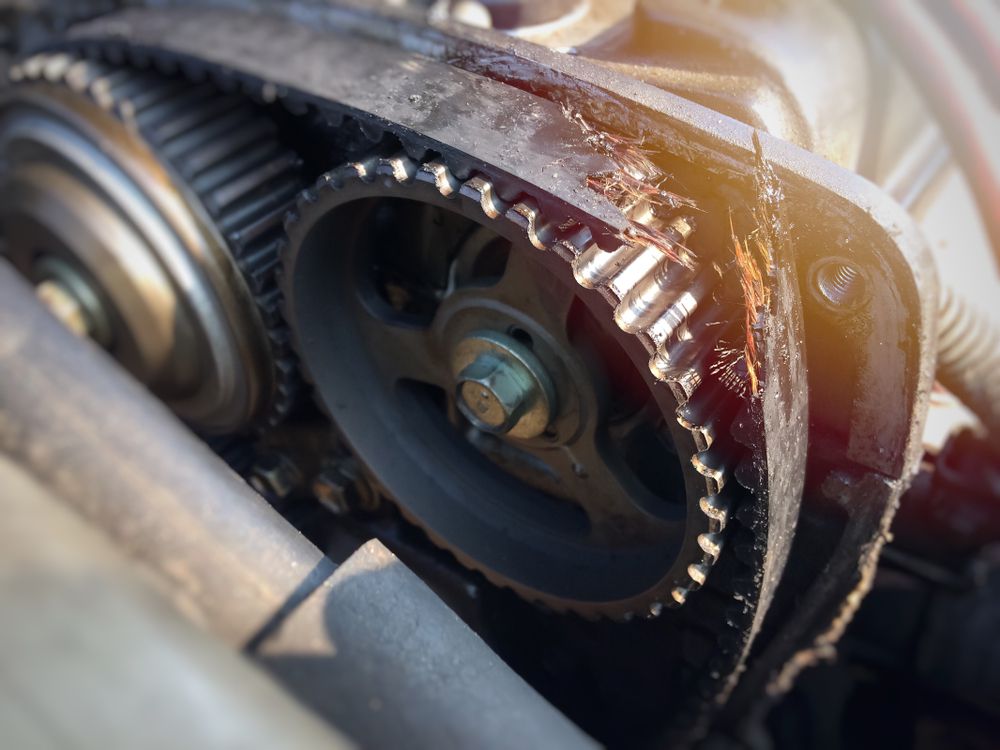What Does A Timing Belt (Cam Belt) Do?
A timing belt, also known as a cambelt, maintains the proper synchronization between the crankshaft and the camshaft. It also is usually responsible for driving the water pump.
The timing belt connects to the crankshaft and camshaft by way of pulleys.
The crankshaft drives the pistons up and down within the cylinder bore, and the camshaft is what opens and closes the valves within the cylinder head.
If the pistons and valves become out of sync, they can contact each
other, causing catastrophic engine damage if the engine is an interference type.
Therefore it is crucial that you know the condition of the timing belt in your vehicle and replace it either at the recommended replacement interval or before if the timing belt is in bad condition.
 Exposed timing belt on an engine
Exposed timing belt on an engine
What Is A Timing Belt Made Of?
The durability of timing belts has improved dramatically over the last 20+ years as material sciences have advanced as most other technologies.
The newer materials withstand heat, oil, and the elements much better than older belts but will still need to be changed at the recommended replacement interval.
 Timing belt in mechanics hands
Timing belt in mechanics hands
Modern timing belts are made of a rubber compound of molded polyurethane, neoprene, or welded urethane.
Timing belts grip the pulleys by way of teeth with different characteristics depending on the application.
What Are The Differences Between A Timing Belt And A Timing Chain?
Most new engines utilize a timing chain in place of a timing belt, but there are still many vehicles on the road with timing belts, and it is essential to know what your vehicle has.
 Exposed timing chain
Exposed timing chain
As the name suggests, a timing chain is a chain made of links much like a bike chain, whereas the timing belt is a belt made of a rubber compound.
You can check if your vehicle has a timing chain or belt in our Belt Or Chain list.
Timing Belt Advantages
- Quieter and smoother engine operation
- Failure won't be catastrophic if your engine is non-interference
- Higher engine efficiency
- More economical engine construction
- No sprocket or tooth wear
Timing Chain Advantages
- Generally good for the lifetime of your vehicle
- Higher load strength
Signs Or Symptoms You Need A New Timing Belt
Age
Timing belts generally have a replacement interval of 60,000 to 120,000 miles or 5 to 7 years.
Check with the manufacturer or dealership for your particular model.
An outwardly fine-looking belt may have weakened significantly and will need replacing if it's at the end of its lifespan.
 Broken timing belt
Broken timing belt
Cracks
Most engines have a timing belt inspection hole in the timing belt cover in which you can visually inspect the belt.
If you see any cracks in the timing belt, it is time for a new one.
MisFires
It is common for a worn belt to jump teeth, setting your timing off and causing your engine to run poorly.
The engine won't start or run
There can be many reasons why an engine won't run, but a broken timing belt will prevent your vehicle from running.
Noise
A ticking sound from the engine or whirring noise can signify a worn or failing timing belt.
IMPORTANT: Interference Or Non-Interference Engine
If the timing belt breaks on an interference engine the valves will come in contact with the pistons and damage the
pistons, valves, heads and cylinder bore resulting in a very expensive repair bill.
No critical damage will occur if the timing belt breaks on a non-interference engine but the car will still need a
tow to get it to the repair shop.
Check Here or with the manufacturer on whether your vehicle has an interference or
non-interference
Timing Belt Replacement
A timing belt change is quite labor-intensive and requires removing many engine components and covers to access the belt.
For this reason, it makes economic sense to replace other parts that are usually hard to access but are now easily accessible while doing the timing belt change.
Timing Belt Kits
Timing Belt Kits usually include some of the following parts.
Water Pump
The water pump or gasket can fail, leading to coolant leaks and engine cooling problems.
Leaking water pump gaskets could allow coolant onto the belt, thereby weakening it.
Belt Tensioner
A sign of a tensioner failing is a ticking noise.
When a tensioner gets weak, it may allow the belt to loosen and jump timing, weaken or break.
Main Seal And Cam Seal(s)
Leaking main and cam seals will expose the belt to engine oil, leading to premature failure.
Balancer Shaft Belt
Some engines have a balancer shaft that is designed to offset the engine's vibrational forces and smooth out the engine.
This is generally belt-driven, and you should change the belt simultaneously with the timing belt.
Idler Bearing
Idler bearings are pressed into the idle pulley and are responsible for guiding and tensioning the engine drive belts.
Can You Replace A Timing Belt Yourself?
If you elect to do it yourself and have all the necessary tools, a timing belt only costs around $20 - $50 USD, with things like the water pump and tensioner adding another 50 USD.
Alert: Be Sure To Buy A High Quality Belt And Components
There are cheap belts online whose quality may be questionable.
Many belts come with a warranty against premature failure.
It is preferable to go with OEM parts in many cases.
If you take your vehicle to a professional shop, expect to pay an additional $300 to $1000 USD, depending on the make and model of your vehicle.
Tools Needed To Replace A Timing Belt
- Jack
- Jack stands
- Wrench set
- Pulley puller
- Hammer, screwdrivers
- Locking Timing Tool Kit - Helps ensure camshaft alignment during removal and installation of the timing belt
In Conclusion
Vehicles with combustion engines are equipped with engines with either timing belts or timing chains.
The timing belt is responsible for maintaining the proper synchronization between the pistons and valves by way of the crankshaft and the camshaft.
Timing chains may stretch over time, but generally, they are good for the engine's life.
However, a timing belt wears over time and will need to be replaced at the recommended manufacturer's replacement interval, if not sooner, if the belt is in bad condition.
If the timing belt slips or breaks and the engine is interference type, the valves will contact the pistons, causing catastrophic engine damage and aa big repair bill.